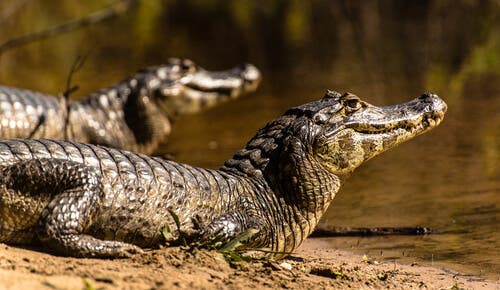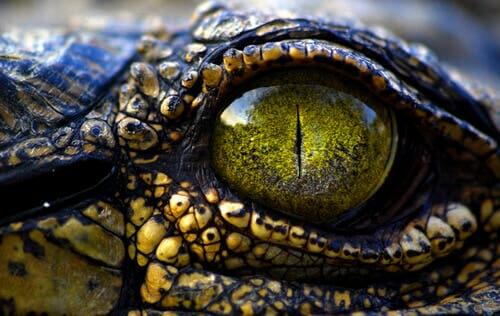The American Alligator, a Silent Predator


Written and verified by the lawyer Francisco María García
The American alligator is one of the most interesting animal species of all. Perhaps it’s due either to their aggressiveness or to the fact that they belong to the Crocodylia family. These animals originated over 83 million years ago. The truth is that this powerful silent predator is unique and their special characteristics are definitely worth learning about.
The mighty American alligator
Firstly, this species belongs to the alligator family and it arouses much interest in humans. They’re powerful and very fierce, but beyond that, they possess extraordinary characteristics.
The American alligator is a subspecies that only lives in the American continent. Also, it’s distribution goes from the state of Florida, USA, to southern South America.
Currently, there are six known species belonging to the alligator family. Three of them are extinct though: Caiman wannlangstoni, C. brevirostris and C. venezuelensis.
The three remaining species are the Spectacled Caiman, which lives from Central America down to Venezuela. The other two varieties of alligators inhabit various areas of South America: the Yacare Caiman and the Broad-snouted Caiman. The latter is also locally known as yacaré.
Characteristics of an American alligator
The most common
The most abundant species in America is the Spectacled Caiman. This variety is generally between 5 and 8 feet long. However, 15 feet long specimens are often spotted in lakes. As for the weight, it can vary between 15 and 138 pounds.

Carnivorous predators
Alligators are carnivorous predators, just like their crocodile cousins. In this respect, their diet consists mainly of small mammals, fish, and even other reptiles. On some occasions, they attack humans, but obviously this usually happens when the animal feels threatened in some way.
Thus, it’s important to note the alligator is a species that usually attacks small mammals because they don’t like working too hard to get their food. It’s for this reason that they only attack humans when we invade their space. This animal won’t hesitate to attack if it feels threatened.
The powerful and fascinating American alligator
The main differences between a crocodile and an alligator
People often confuse crocodiles and alligators. But, although they belong to the same family, there are certain characteristics that differentiate them. The main one is size – crocodiles are usually considerably larger than alligators. Also, the snout is rather characteristic so it’s helpful to differentiate them. In this respect, the shape of a crocodile’s snout has a “U” shape, while that of the alligator is pointy like a “V.”
Reproduction
Alligators reproduce in the rainy season; the female builds a nest and lays between 15 and 50 eggs in it. She incubates them for 12 weeks until the cuties finally break the shell. When this happens, parents protect and move the little ones to a safer area where they’ll also teach them to swim and hunt. This development process takes a few weeks.

The life expectancy of an American alligator
The life expectancy of an alligator in its natural habitat is 30 to 40 years of age. Alligators in captivity live longer as long as they have an adequate environment and plenty of food.
This is mainly due to the fact that the animal has a controlled environment and veterinarian care.
The American alligator is one of the oldest and most fascinating animal species on the planet. These ferocious-looking creatures, who cope perfectly well in both water and on the land, are rather unique and never cease to arouse human interest.
All cited sources were thoroughly reviewed by our team to ensure their quality, reliability, currency, and validity. The bibliography of this article was considered reliable and of academic or scientific accuracy.
- Balaguera-Reina, S.A. & Velasco, A. (2019). Caiman crocodilus. The IUCN Red List of Threatened Species, e.T46584A3009688. https://www.iucnredlist.org/species/46584/3009688
- Choi, H. (2004). Paleosuchus palpebrosus (On-line). Animal Diversity Web. Consultado el 18 de julio de 2023. https://animaldiversity.org/accounts/Paleosuchus_palpebrosus/
- Fernández Blanco, M. V. (2018). Análisis morfológico del esqueleto de las especies argentinas del género Caiman (Alligatoridae: Caimaninae). Aportes al conocimiento de la historia evolutiva de los alligatóridos sudamericanos. Universidad Nacional de La Plata. http://sedici.unlp.edu.ar/handle/10915/65600
- Sydlowski, R. (2000). Melanosuchus niger (On-line). Animal Diversity Web. Consultado el 18 de julio de 2023. https://animaldiversity.org/accounts/Melanosuchus_niger/
- Terry, K. (2010). Caiman crocodilus (On-line). Animal Diversity Web. Consultado el 18 de julio de 2023. https://animaldiversity.org/accounts/Caiman_crocodilus/
This text is provided for informational purposes only and does not replace consultation with a professional. If in doubt, consult your specialist.